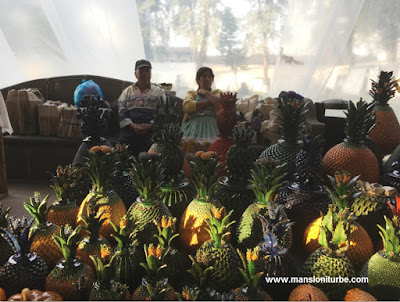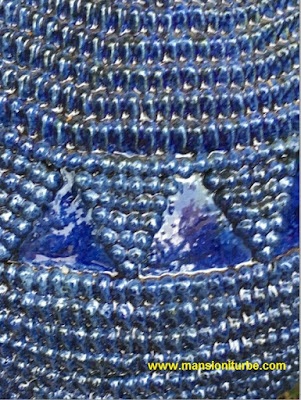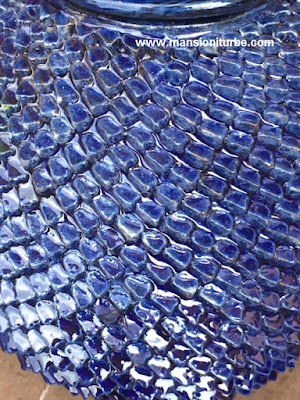Mexican Folk Art: Clay Pineapples of San José de Gracia
Among Mexican handcrafts, the
clay pineapples from San José de Gracia,
are one of the most representative of Michoacán
folk art.
 |
| Mexican Pottery: Clay Pineapples of San José de Gracia |
 | |
| Mexican Decorations at Hotel Mansion Iturbe in Patzcuaro
Year after year, our guests buy up a storm at the craft fairs in the Plaza Vasco de Quiroga, which take place the week of Night of the Dead and as well as during Easter week, as well as at the renowned Palm Sunday artisan fair in Uruapan, a short distance from our magical village.
Handicraft Items: Clay Pineapples of San José de Gracía, Michoacán
José María Alejos Cerano is proud of his Purépecha culture and of the craft tradition in his family, and explains how it evolved.
Mexican Pottery made by Jose Maria Alejos and his wife.
Don Vasco de Quiroga was instrumental in organizing the craftsmen in the various towns
around Lake Pátzcuaro, and San
José de Gracia was to be a center for utility jugs, pots, and pans. Some
years ago, José’s grandmother Doña Elisa Madrigal Martinez ventured to alter the
tradition and designed and created the first pineapples. She brought her piece
to the artisan fair in Pátzcuaro and
won an award for innovation, and her pineapple was displayed at the Folk Art Museum.
Mexican Decorations at the Folk Art Museum in Patzcuaro
|
Subsequently, the grandmother continued fine-tuning her design and her
family of five children pitched in, and they continued to receive
awards. José María Alejos
Madrigal has worked pottery since the age of 10 (he’s 67 now), and has
handed down the craft to his own children.
 |
| Mexican Pottery: Clay Pineapples of San José de Gracia |
In the beginning, only green and brown pineapples were made.
Subsequently, the yellow variety was introduced by Daniel Diego Ortiz.
José María Alejos
Madrigal then introduced blue, using a lead-free
glaze. Today,
we can see other exciting hues.
The process involves letting the mud begin to dry
completely. It is then ground to a fine powder and water is
reintroduced to the perfect texture, followed by kneading, and letting it stand
and settle for 2 or 3 days.
Afterward, two molds are used to give the shape of the pot, and are left
to set for a day. Then the feet are added, and the intricate
decorations are added.
The technique uses a hand-molded paste, using the tips of the
fingers. It is allowed to dry in the shade for 2 or 3 days, then in
the sun for 7 to 10 days.
When dry, a white paste is applied and the pineapple is put in a
wood-fired oven at a low temperature so it won’t crack. Once fired, it is
glazed with the chosen color. Though the shape of the object is
unmistakably that of a pineapple, the surface of the shape may include small
shells, flowers, smaller pineapples, and other shapes.
The lids of the pineapples can be as diversified, sometimes introducing things such as calla lilies.
 |
| Mexican Pottery from San Jose de Gracia, Michoacán |
 |
| Mexican Folk Art from San José de Gracia, Michoacán |
 |
| Mexican Pottery from San José de Gracia, Michoacán |
 |
| Mexican Pottery from San José de Gracia, Michoacán |
 |
| Mexican Folk Art from San José de Gracia, Michoacán |
 |
| Mexican Pottery from San José de Gracia, Michoacán |
The lids of the pineapples can be as diversified, sometimes introducing things such as calla lilies.
Once again, with the glaze applied, it is put back into the wood-fired
oven for another 3 hours to set the glaze.
The artisans of San José de Gracia are very creative and are constantly innovating. Currently, we can find shapes other than pineapples. Piggy banks are now a hot item; they can be in the shapes of roosters, pigs, candle holders, and pumpkins.
José María Alejos Cerano says that an ideal day of the year for visiting his indigenous community is the second Sunday of July, which is the local competition, normally held at the school football field.
The artisans of San José de Gracia are very creative and are constantly innovating. Currently, we can find shapes other than pineapples. Piggy banks are now a hot item; they can be in the shapes of roosters, pigs, candle holders, and pumpkins.
 |
| Handicrafts Items form San José de Gracia Michoacán |
José María Alejos Cerano says that an ideal day of the year for visiting his indigenous community is the second Sunday of July, which is the local competition, normally held at the school football field.
 |
| Mexican Folk Art Artists Jose Maria Alejos Ceron, Jose Maria Alejos Madrigal and Cecilia Ceron Gutierrez |
The indigenous community of San
José de Gracia, municipality of Tangancícuaro, is located approximately
two-and-a-half hour from Pátzcuaro.
We encourage you to visit this community and marvel at their creations
of Mexican folk art!
*Text and pictures property of Hotel Mansión Iturbe in Pátzcuaro.
We invite you to check more post in our blog, you will find information about Pátzcuaro and the surroundig area, that we hope will be useful for your next trip to our colonial town.
Here are some post that we suggest you:
Cantera Stone in Patzcuaro and the Lake Region
Those Crazy Masks of Tocuaro
Capula, Home of the Catrinas
*Text and pictures property of Hotel Mansión Iturbe in Pátzcuaro.
We invite you to check more post in our blog, you will find information about Pátzcuaro and the surroundig area, that we hope will be useful for your next trip to our colonial town.
Here are some post that we suggest you:
Cantera Stone in Patzcuaro and the Lake Region
Those Crazy Masks of Tocuaro
Capula, Home of the Catrinas
Hotel
Mansión Iturbe
Portal
Morelos 59
Plaza Vasco
de Quiroga
6100 Pátzcuaro,
Michoacán
México.
Tel: +52 (434) 342
0368
Fax: +52 (434) 342
3628
Toll Free fax number from USA
& Canada: 1-866 678 6102
GDS
CODES:
Amadeus: ON
MLMMAN
Sabre: ON
16297











Comentarios